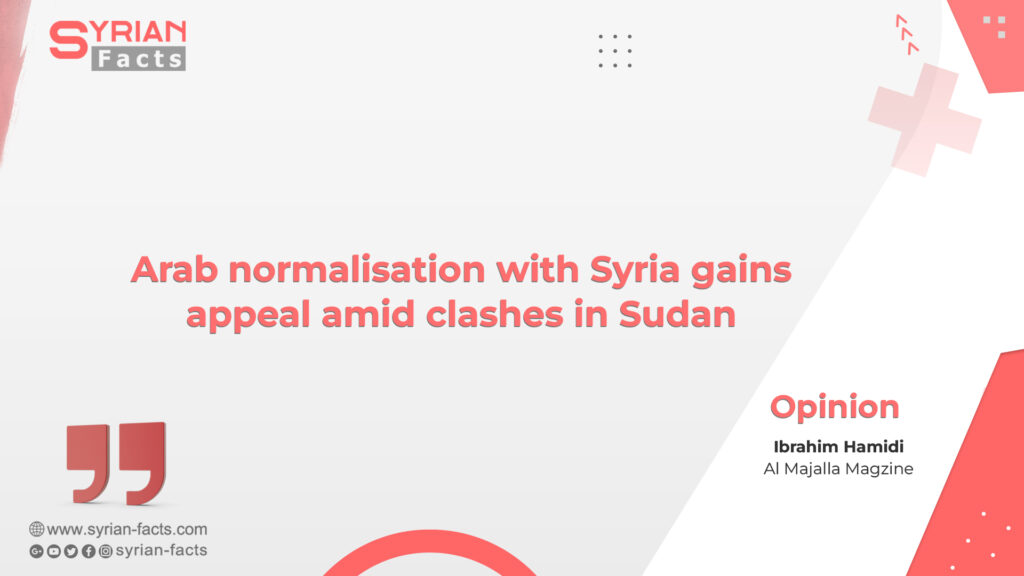The recent events in Sudan have placed Syria, once again, in the spotlight. In the last decade, many regional and international attempts have been made to heal Syrians’ wounds, but as attempts eventually faltered, wounds continued to deepen.
Hopes for a peaceful transition of power in 2011 didn’t happen, then hopes for a military coup in 2012 faltered. Finally, hopes for American intervention — a last resort attempt at regime change — also didn’t come to pass when President Barack Obama decided against it in 2013. Instead, Russia intervened in 2015, sending its army to help Damascus regain control over the suburbs.
The rest of the country was carved up into areas controlled by an array of foreign powers. These smaller ‘states’ were supported by foreign armies, no-fly zones, and either local or foreign militias — some were even governed by internationally-recognised bodies.
Syrians displaced in the war live in some of these areas now — places where destruction, darkness and suffering are commonplace, and warlords rule.
Unrealistic diplomatic solution
Against this backdrop, a wishful but unrealistic diplomatic solution was proposed: the Sudanisation of Syria.
This involves the formation of a sovereign council comprising military personnel from the army and militias, as well as civilians and their supporters, to oversee a transitional period that would prepare for elections and pave the way for civilian rule that unites the country and its people.
However, this proposition has been soured by recent clashes, raids, and strikes in Sudan, highlighting the difficulties of implementing such a model. Similar to the Tunisian model and other proposals, internal developments and geopolitical calculations can derail such well-intentioned initiatives.
A shift toward the normalisation route
Instead, what is happening in Sudan makes normalisation with Damascus — an option currently being explored by some Arab states —a much more appealing option.
Arab leaders seemed to be convinced that Syria needs to be reintegrated into the Arab world, whether through resumption of bilateral relations or readmission to the Arab League. However, Arab states disagree on how to go about this.
Recent Arab meetings, including the ministerial meeting of the Gulf Cooperation Council, Egypt, Jordan, and Iraq in Jeddah, show the push for normalisation is definitely happening. However, the speed, cargo and passengers on this normalisation train, remain a subject of dispute.
Shifting priorities
Arab states are increasingly seeing the strengthening of the Syrian regime as a necessary step to limit Iran’s military expansion into the region. They also see the need to form a northern front against Turkish encroachment.
Strengthening Syrian institutions is deemed crucial to regaining control, stopping militias and terrorists, controlling borders, and dismantling drug networks.
UN Resolution 2254 which calls for political transition in Syria is no longer being discussed in Arab circles in the same way. Instead, Arabs are primarily concerned with the fostering of necessary conditions for the return of refugees and internally displaced people, as well as the infrastructure required for their return, along with support and humanitarian aid for those in need.
Arabs are currently debating whether they should offer upfront incentives to Damascus in exchange for Arab normalisation or if it should first lay out preconditions. In the meantime, until a collective decision is reached, bilateral normalisation continues.
A comfortable approach
Individual countries are working independently to develop their relations with Syria — a comfortable approach that spares them the need to save face and allows each country to specifically negotiate what it needs from Syria. This approach also works for Damascus as it exempts it from making sweeping concessions and allows it to play upon Arab rivalries.
It also allows gives Damascus room to maneuver between Arab normalisation and Turkish rapprochement, as well as between its Russian and Iranian allies. Arab normalisation has emboldened Damascus and it has toughened its language with Ankara ahead of the Syrian-Turkish-Russian-Iranian ministerial meeting in Moscow on 2 May, despite pressure from Moscow.
One advantage of this approach is that it allows Syria to navigate around Western pressures, as US, European, and British sanctions are still in place. Moreover, the Caesar Law looms over both private and government institutions, and Israeli raids continue to target Iranian military assets, even escalating in recent days.
Tit-for-tat attacks between Iran and the US in Syria have also intensified, coinciding with Arab normalisation and shifting regional priorities. It seems that the war between Iran and both the US and Israel being waged in the shadows has now come out into the open.
Strength in weakness
It can be said that Damascus’ strength lies in its weakness, to some extent. It finds itself at the centre of a power struggle between powerful global actors. Iran and Israel are fighting in Syrian airspace and soil. To a lesser extent, America and Russia are fighting with each other on the banks of the Euphrates River.
Meanwhile, the war in Ukraine has also impacted the conflict and the various interests of global actors there. On their part, Arab countries are linking normalisation with Damascus to their rivalries with Iran and Turkey and their evolving diplomatic relationships with the US and Russia.
However, while Syria has become the focal point of international and regional attention, its people remain forgotten.
Al Majalla Magzine





Be the first to write a comment.